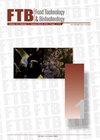Development of an Antioxidant-Rich Sugar-Free Plantain Candy and Assessment of Its Shelf-Life in a Flexible Laminate
IF 2.3
4区 农林科学
Q3 BIOTECHNOLOGY & APPLIED MICROBIOLOGY
引用次数: 0
Abstract
Research background. Candy is a popular confection worldwide, and it would be of societal benefit if it could be converted into a source of antioxidant molecules, to eliminate their adverse health effects. The amount of antioxidants available even in fruit candies is questionable due to the high thermal processing losses they undergo and the presence of various food additives. Plantains (Musa paradisiaca) are less known as good sources of biotherapeutic antioxidants, namely L-tryptophan, serotonin, and melatonin, and consumption of this highly nutritious fruit is limited to underdeveloped and developing countries. The objectives of this current study are: to develop a functional antioxidant-rich sugar-free plantain-based candy with appreciable contents of the mentioned biomolecules in synergy; and to ensure its extended shelf-life without compromising its physicochemical properties and functionalities by wrapping it with a suitable packaging laminate. Experimental approach. To accomplish the first objective, lyophilized plantain powder, sorbitol, and mannitol were used as base materials with minimal additives under minimal processing conditions to reduce processing losses. After development, the developed candies were evaluated for their sensory, proximate, physicochemical, and phytochemical properties, including the antioxidant synergy among the mentioned biomolecules. For the second objective, the candies were enclosed in two different flexible packaging laminates, and the optimal wrapper was determined based on the microbiological safety and sensory appeal of the packaged candies. Subsequently, the above-mentioned properties were assessed for the packaged (in the most suitable laminate) candies at regular time intervals during storage for assessment of their shelf-life. Results and conclusions. The candy exhibited a characteristic flavour of plantain, uniform dark brown colour, rich mouthfeel, pleasant aroma, moderately hard texture, and moderate sweetness, along with high antioxidant activity and considerable content of L-tryptophan, serotonin, and melatonin (present as a synergistic consortium). During storage of the packaged candy under ambient conditions, it remained microbiologically safe for up to 56 days, and also maintained sensory attributes, antioxidant potency, and synergy compared to the control candy. Novelty and scientific contribution. It is envisaged that this newly developed semi-hard antioxidant-rich sugar-free candy containing three important antioxidants, namely L-tryptophan, serotonin, and melatonin, could be a food matrix for molecular nutrition and a substitute for commercial candies consumed globally.开发富含抗氧化剂的无糖车前草糖果并评估其在软质层压板中的货架期
研究背景。糖果是一种风靡全球的糖果,如果能将其转化为抗氧化剂分子的来源,消除其对健康的不利影响,将对社会大有裨益。即使是水果糖中的抗氧化剂含量也值得怀疑,这是因为水果糖在热加工过程中损失较大,而且还含有各种食品添加剂。大蕉(Musa paradisiaca)作为生物治疗抗氧化剂(即 L-色氨酸、血清素和褪黑激素)的良好来源鲜为人知,这种高营养水果的消费仅限于欠发达国家和发展中国家。目前这项研究的目标是:开发一种富含抗氧化剂的功能性无糖车前草糖果,其中含有可观的上述生物大分子协同作用;通过使用合适的包装层压板将其包裹起来,确保在不影响其理化特性和功能的情况下延长其保质期。为了实现第一个目标,实验采用了冻干车前草粉、山梨醇和甘露醇作为基础材料,在最小的加工条件下使用最少的添加剂,以减少加工损失。开发完成后,对开发的糖果进行了感官、近似物、理化和植物化学特性评估,包括上述生物大分子之间的抗氧化协同作用。第二个目标是将糖果封装在两种不同的软包装层压板中,并根据包装糖果的微生物安全性和感官吸引力确定最佳包装。随后,在贮藏过程中每隔一段时间对包装好的糖果(在最合适的层压板中)的上述特性进行评估,以评估其保质期。结果和结论该糖果具有车前草的特有风味、均匀的深棕色、丰富的口感、怡人的香气、适中的硬度和适度的甜度,同时还具有较高的抗氧化活性和相当高的 L-色氨酸、血清素和褪黑素含量(作为一个协同的联合体存在)。与对照糖果相比,包装糖果在常温条件下贮存长达 56 天,仍能保持微生物安全,并保持感官属性、抗氧化效力和协同作用。新颖性和科学贡献。预计这种新开发的富含抗氧化剂的半硬质无糖糖果含有三种重要的抗氧化剂,即 L-色氨酸、5-羟色胺和褪黑激素,可作为分子营养的食品基质,并可替代全球消费的商业糖果。
本文章由计算机程序翻译,如有差异,请以英文原文为准。
求助全文
约1分钟内获得全文
求助全文
来源期刊

Food Technology and Biotechnology
工程技术-生物工程与应用微生物
CiteScore
3.70
自引率
0.00%
发文量
33
审稿时长
12 months
期刊介绍:
Food Technology and Biotechnology (FTB) is a diamond open access, peer-reviewed international quarterly scientific journal that publishes papers covering a wide range of topics, including molecular biology, genetic engineering, biochemistry, microbiology, biochemical engineering and biotechnological processing, food science, analysis of food ingredients and final products, food processing and technology, oenology and waste treatment.
The Journal is published by the University of Zagreb, Faculty of Food Technology and Biotechnology, Croatia. It is an official journal of Croatian Society of Biotechnology and Slovenian Microbiological Society, financed by the Croatian Ministry of Science and Education, and supported by the Croatian Academy of Sciences and Arts.
 求助内容:
求助内容: 应助结果提醒方式:
应助结果提醒方式:


